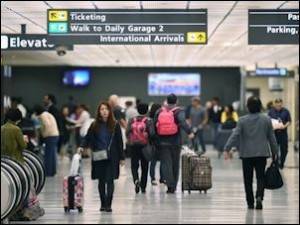by James A. Bacon
The Washington Post has taken notice of the fact that Washington Dulles International Airport, widely regarded as an economic engine of Northern Virginia, is in trouble. Sometime next year, notes Lori Aratani, more passengers will be traveling through Reagan National Airport in Arlington, than through Dulles, an airport with fourteen times the land mass.
Dulles suffers from the perception that it is a hassle to use. Indeed it is, compared to National, which is located in the metropolitan core. But, then, Dulles, located on the metropolitan fringe, has always been a hassle to use. When growing up in Washington, D.C., in the 1960s, I once went on a joy ride (no alcoholic beverages consumed) to Dulles and I remember driving through miles and miles of empty countryside. Since then, the dairy farms along the Dulles Access Road have been transformed into one of the nation’s leading technology corridors. The center of gravity of development in Northern Virginia has migrated steadily closer to Dulles over the years, so it’s hard to imagine that getting to Dulles is more of a hassle today than it always has been.
No, something else is responsible for Dulles’ woes. Officials with the Metropolitan Washington Airports Authority, which runs both Dulles and National airports, blame Congress for tinkering with the decades-old rule that limit the number of takeoffs and landings at National. Restrictions at National effectively capped passenger traffic there, pushing traffic out to Dulles. Since 2000, Congress has weakened those restrictions. Between 2011 and 2013, Dulles lost nearly 200,000 seats to National. Sequestration also has clobbered the Washington economy, especially among government contractors along the Dulles Corridor who are most likely to choose to fly out of Dulles. United Airlines, which accounts for about 65% of the flights at Dulles, says it lost 10% of its traffic due to sequestration.
MWAA’s response, according to Aratani’s story, has been to staunch the flow of passengers to National. A new agreement with airlines would require airlines to compensate MWAA, she writes, if Congress opens the door to more long-distance flights out of National. In other words, MWAA’s strategy for Dulles is to restrict National’s competitive advantage in the marketplace and restrict the choices of Washington-area travelers.
Aratani neglects to mention the recent Bloomberg survey indicating that Dulles scores third highest among all major U.S. and Canadian airports for traveler frustration on metrics that include security, restrooms and shopping. Apparently, MWAA has acted on the latter concern by adding high-end shopping and dining options, including Montblanc and the District Chophouse, but there is no indication in Aratani’s story that the board even acknowledges the other problems.
Also, MWAA been a major driver behind the building of the Silver Line extension from Washington’s Metro system. The second phase , expected to be completed in 2018, will include an airport station. MWAA will pay for only a tiny sliver of the capital construction costs of the multibillion-dollar project, the financing of which represents a massive wealth transfer from commuters on the Dulles Toll Road and general taxpayers to the riders of the rail line. Rail passengers to Dulles will pay a fraction of the fare to travel the same distance as the toll road commuters who are actually paying for the rail.
MWAA and its allies in the air cargo business also have lobbied for hundreds of millions of dollars worth of road and highway improvements, including, most notoriously, the controversial Bi-County Parkway designed to facilitate air cargo traffic.
It strikes me that MWAA has focused its attention overwhelmingly on building Dulles through rent seeking — restricting flights from National, building the Rail-to-Dulles project at others’ expense, and dunning Virginia taxpayers to subsidize a highly speculative air cargo boom — rather than tending to the nuts and bolts of creating an airport that passengers want to use. Maybe the board needs to spend more time thinking about enhancing the visitor experience through such mundane things as tighter security, cleaner bathrooms and more dining options.
Update: I am reminded by Reed Fawell’s comment on this post of the catastrophic over-expansion of Dulles in the 2000s, leaving the airport saddled with enormous debt and high costs. In that high-stakes gamble, Dulles built “perhaps the world’s largest useless vestibule” as well as “a ridiculously expensive underground transport system,” both of which were compounded “by a long history of duplicate work, horrendous cost overruns, and throttling of customer demand.” Reed has documented some of these disastrous decisions on this blog, but the full story has never been written.
A question that Ms. Aratani — or others — might ask is how those high embedded costs are reflected in ticket charges to passengers and terminal charges to airlines.



